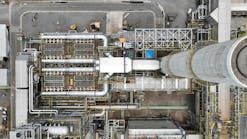CSB releases final report on Chevron Richmond refinery fire
The US Chemical Safety Board (CSB) has issued the final regulatory report on its investigation of the August 2012 pipe rupture and ensuing fire at Chevron Corp.’s 257,000-b/d Richmond, Calif., refinery, in which the agency reinforced its call for a more-rigorous approach to safety management at US refineries.
CSB released the report, which received unanimous approval by agency board members, on Nov. 10.
The second of three parts in CSB’s investigation of the Aug. 6, 2012, process fire and vapor release at the Richmond refinery’s crude unit (OGJ Online, Aug. 7, 2012), this latest report reiterates CSB’s previous recommendation for California and US refiners to implement a safety case regulatory regime similar to that already adopted by refiners in Norway, the UK, and Australia (OGJ Online, Dec. 17, 2013).
The shift to a safety-case regime would represent a fundamental change to current US practices by shifting the responsibility for continuous reductions in major accident risks from regulators to the company by requiring companies to demonstrate to refinery industry regulators—through a written “safety case report”—how major hazards are to be controlled and risks reduced to as low as reasonably practicable.
Specifically, the report describes attributes of the safety case regulatory scheme that would help to transform the US’s currently “reactive” PSM system into a more proactive one, according to CSB.
Worker, safety requirements
In contrast to the PSM system used by US federal and state regulators today, the safety-case regulatory regime would improve worker and public safety by requiring:
• More comprehensive process hazard analyses.
• Documented use of inherently safer systems analysis and the hierarchy of controls to the greatest extent feasible, with the goal of continuous risk reduction to a specified risk target.
• Analyses of the effectiveness of safeguards intended to control hazards.
• Effective use of process safety indicators that drive performance.
• More thorough inspections and audits by a technically qualified regulator.
These enhancements would provide US regulators the adaptability necessary to keep current with improving standards and advancing technology, without requiring the regulatory bodies to engage in the process of lengthy and often unproductive rulemaking, CSB said.
The agency also lauded the California Division of Occupational Safety and Health’s (Cal/OSHA) recent move to revise and strengthen PSM requirements for state refiners with the September release of its Draft Process Safety Management for Refineries Regulation (PSMRR).
In addition to incorporating a risk-reduction goal of “the greatest extent feasible” for process hazard analyses, Cal/OSHA’s draft PSMRR proposes new requirements such as performing damage mechanism reviews and hierarchy of controls analyses.
“California’s draft regulations address numerous issues raised in the CSB regulatory report, and the CSB will be monitoring the California rulemaking process closely to see if those provisions remain in the final rule,” said CSB Chair Rafael Moure-Eraso.
CSB said it will release the third part of its investigation into the Richmond refinery fire at a public meeting in mid-December.
In its first report on the incident, CSB found that Chevron repeatedly failed over a 10-year period at the Richmond refinery to apply inherently safer design principles and upgrade piping in the crude oil processing unit, which was extremely corroded and ultimately ruptured by the time of August 2012 incident (OGJ Online, Apr. 15, 2013).
Had Chevron identified and evaluated damage mechanism hazards, the possibility of a catastrophic sulfidation corrosion-related piping failure likely would have been detected and prevented, according to CSB.
Contact Robert Brelsford at [email protected].

